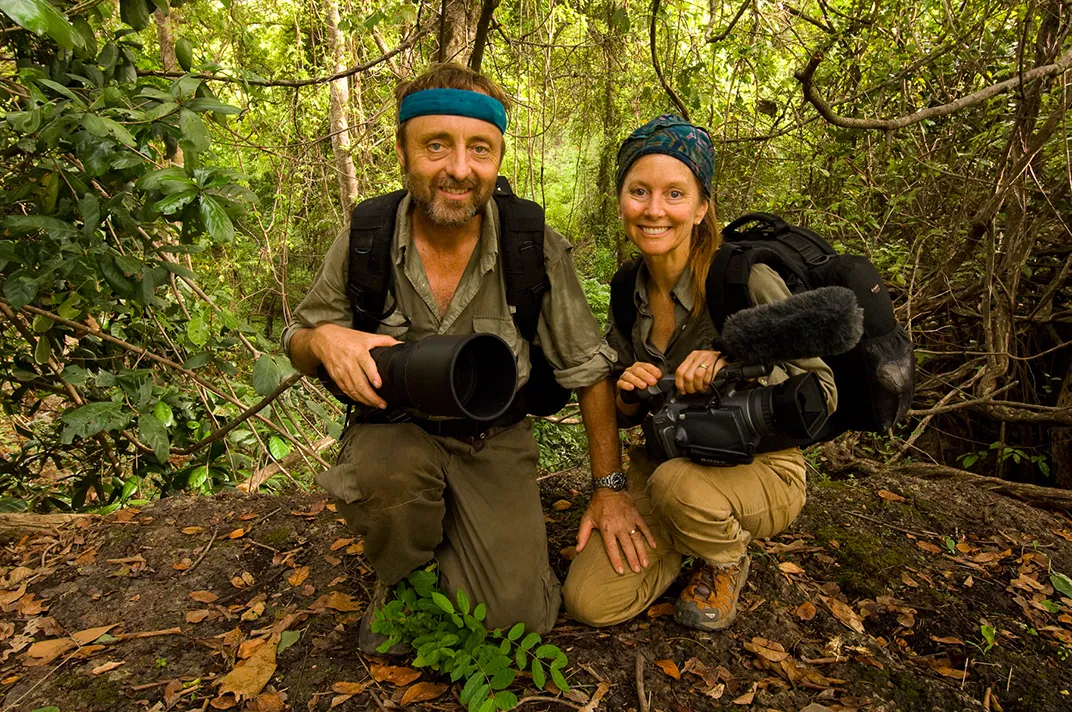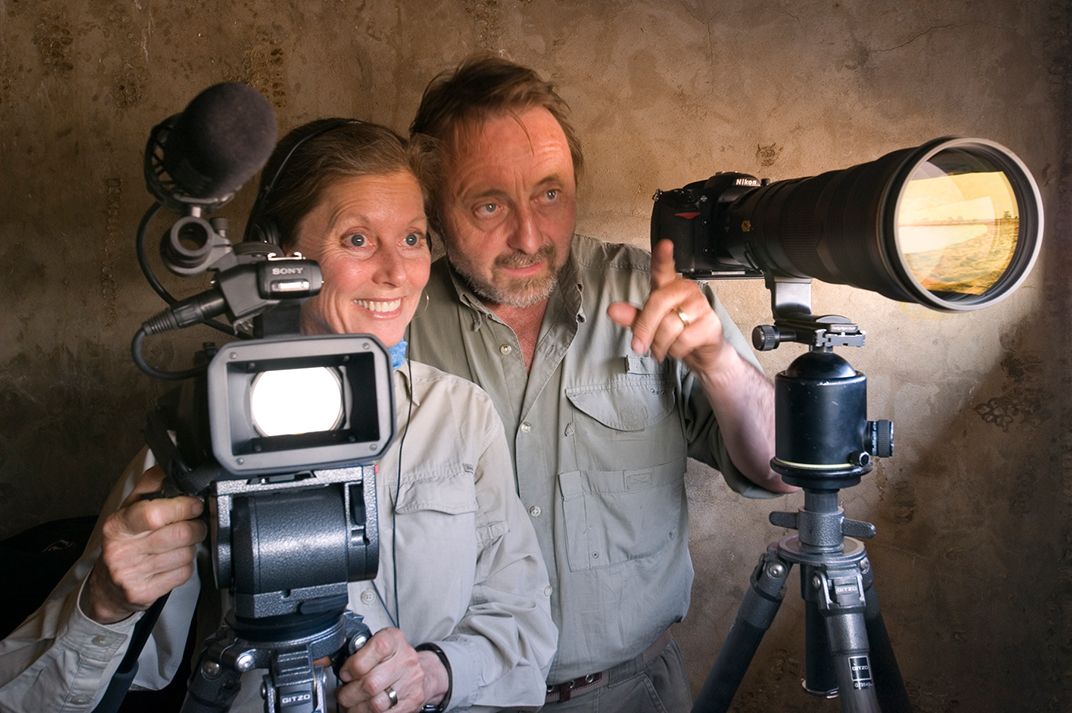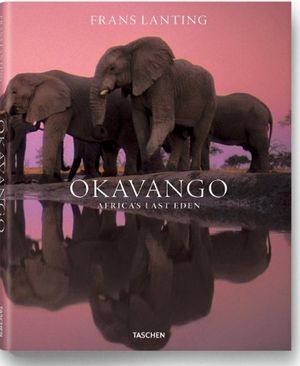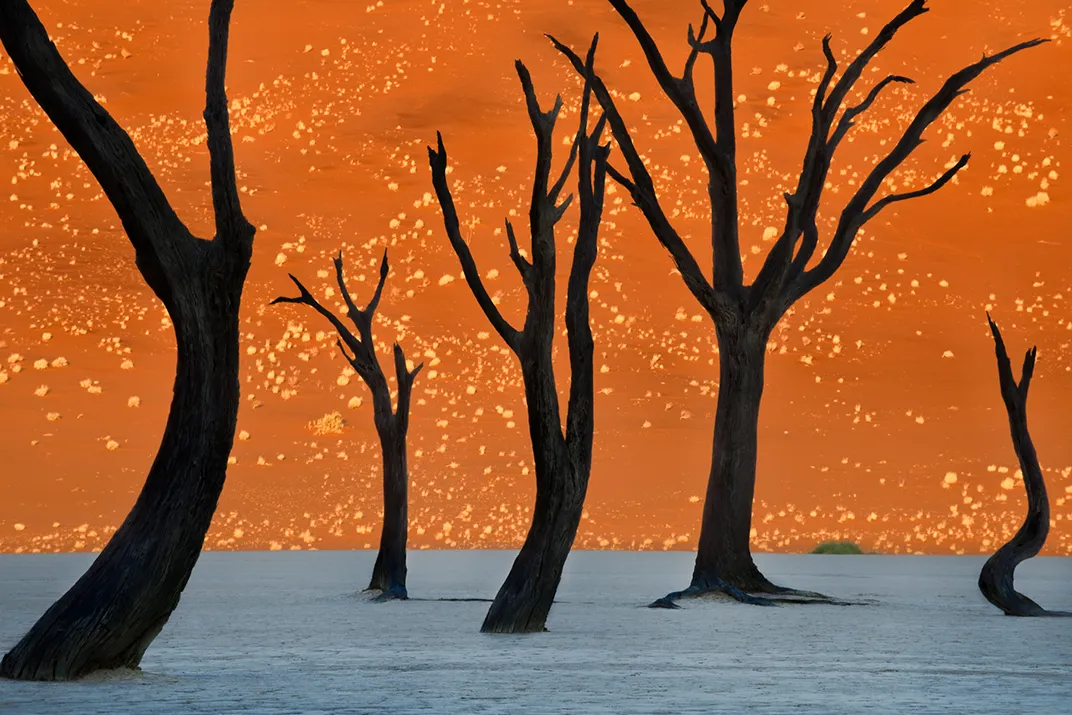Wildlife Photographer Frans Lanting on the Difference Between Taking Pictures and Making Photographs
The National Geographic photographer has been described as having the “mind of a scientist, the heart of a hunter, and the eyes of a poet”
The aye-aye is a rare, nocturnal Madagascar primate with a bushy tail that resembles a cross between a squirrel and a possum and grows to about 16 inches long. For its bizarre appearance, it has been called the world’s strangest primate. Thirty years ago, nature photographer Frans Lanting, on assignment for National Geographic magazine set out to track the elusive primate to capture it on film. At the time, there were “practically no photographs of aye-ayes, ” he says.
“Frans became known before he even reached a village as ‘The man who searches for aye-aye,’” says Chris Eckstrom, Lanting’s wife, a videographer and former National Geographic writer, on a recent tour of the show.
“The local people are so fearful of those creatures that they often didn’t even want to hear the name pronounced,” Lanting adds. “It’s associated with evil and bad luck.” But a farmer finally led him to a place where an aye-aye could be seen in the tree canopy scooping out the flesh of a coconut.
Lanting's image of the aye-aye is one of more than 60 currently on view in the new exhibition, “National Geographic Into Africa: The Photography of Frans Lanting” at the National Museum of Natural History in Washington, D.C., which includes a booth where viewers can snap selfies in front of one of Lanting's wall-sized images of two rhinoceroses.
Lanting sees the explosion of interest in photography, including the sort that is sure to happen at the rhino photo booth, as refreshing. Where photography was once a highly specialized activity, now anyone with a smartphone can take and share photographs. “There’s no excuse not to take pictures,” Lanting says. “Everyone is a citizen with a camera in their hands. We know with recent social issues and political eruptions how important that is.”
Amateur photographers can also get very creative with their smartphones and apps. “I think we are just seeing the beginning of a new era in photography,” Lanting says. “What it does to the more deliberate kinds of photography, of which this exhibition is a result—hopefully it’ll stimulate a small percentage of the people who start with this to consider taking the next step from taking pictures to making photographs.”
Walking through the exhibition with Lanting and Eckstrom and hearing some of the stories behind the photographs, one has a sense of what former National Geographic photography director Thomas Kennedy meant when he said of Lanting: “He has the mind of a scientist, the heart of a hunter, and the eyes of a poet.”

Asked about the description, Lanting says: “You have to be analytical. If you don’t understand what you are photographing, you are just looking at the surface of things. If you can’t get into this dance with wild animals, you remain a scientist,” he says. “There’s an interaction that goes on between animals and myself, and I’m working with them. It’s not as simple as sitting there and aiming a large telephoto lens from a great distance.” Although he isn’t a hunter, there are aspects of his photography that resemble hunting, Lanting adds. “And ultimately, you have to be able to express things in a way that is lyrical and poetical, or else it’s just a record.”
Even if the overwhelming majority of the works in the show are “realistic,” some of Lanting’s works on display in “Into Africa” have abstract components. The image “Hunters Reflected,” taken in Botswana in 1989, shows a detail of a zebra’s head, but in its green eye, there is a hint of a reflection of the trophy hunter who shot it, a hunting guide, and Lanting himself. The work shifts the focus from the humans to the animal, whose stripes and eyelashes dwarf the tiny reflected figures. Lanting framed the work that way, he says, not to condemn hunting, but to “make it more of an abstraction of the activity itself.”
Botswana’s president recently placed a moratorium on all hunting in the country. “That’s a bold move,” Lanting says. “There was an era when people went to Africa to connect with wildlife through the [clicking sound], through a gun. These days, it’s mostly through a camera, or through binoculars. That’s certainly a more sustainable activity.”
The photograph of the zebra epitomizes what Lanting describes as the couple's artistic process. “What Chris and I do together is to not just [capture] the surface beauty, but also to come up with an interpretation of the wild places and the wild places that are dear to our hearts,” he says. “There’s a lot of technical and aesthetic considerations that go into how I frame a situation, but at the same time we are thinking of the storytelling. And that is, of course, part of the great tradition at National Geographic.”
Lanting credits his wife with helping put words to his photographic vision, and nowhere is that more pronounced than in “Bullfrog,” also taken in Botswana in 1989, which depicts a huge, semi-submerged frog in the foreground, as grass and trees appear along the high horizon line. “Bullfrogs in the Kalahari Desert lead secret lives. For most of the year they hide underground, encased in a protective membrane, until the first heavy downpours bring them back to the surface,” reads the wall label. “By the edge of a rain-filled pool, I crept up to this male on hands and knees to create a portrait of seasonal rebirth, expressed in a face larger than life.”
The lengthy National Geographic assignment, Lanting adds, had him searching for images that were symbolic of broader themes, rather than just specific animals. He used a wide-angle lens to enlarge the frog—which he shuffled closer to each time it ducked under the water to wet its skin. “We ultimately had a pretty close encounter,” he says, noting also the billowing clouds atop the composition. “Everything says it’s the beginning of the season of plenty.”
Creeping up on animals can be a struggle at the beginning. “You can’t go to school for this kind of work. You have to learn by doing it,” Lanting says. “I made all the mistakes myself. I just got better and better at it.”
Asked about his safety shooting photographs in the wild, particularly after a lion mauling made the news recently, Lanting says it comes with the territory. “When you work with nature, there are uncertainties,” he says. “I believe that if you understand the situation, and you understand the animals, a lot of the myths about animals that are dangerous give way to very specific situations, where we can often gauge what is the right thing to do.”
That said, Lanting notes that one never quite knows how a hippopotamus (like the one gaping in “Hippo” in the show), an elephant, or a lion will react. “The core of a hippo threat display is a wide-open gape, a gesture sometimes mistaken for mere yawning. But what I saw through my lens could not be mistaken: His upright body position, perked ears, and bulging eyes were exclamation points on his emotion. I lingered only long enough to expose a few frames,” the wall label notes.
“We are not just operating from the safety of a Land Rover. Sometimes we are out there on foot or we are lying on our stomach. You’re never quite sure,” Lanting says. But he is quick to prescribe that humans shoulder the blame. “I don’t want to put a burden on animals and make them dangerous. If we are so smart, we should know better,” he says. “The key to this work is to pay respect to the animals, the places and the people you work with.”
Animals give signals, Eckstrom adds. “If you watch carefully, they’re letting you know how comfortable they are with your presence and your approach. If you read their language, then you either know that it’s OK to move in a little bit more, or back off,” she says. Elephants, for example, flap their ears, raise themselves up, and shuffle their front feet.
“Elephants are very expressive. Crocodiles are harder. They’re not as expressive,” Lanting says.
Beyond the potential for danger on their shoots, nature photographers also endure daily routines that evoke military training.

“A lot of people say, ‘Your job is so much fun. It’s so glamorous.’ Sometimes I take the trouble to describe a typical day in the life, or something like that. And people go, ‘Ew! I couldn’t do that,’” Eckstrom says. One example, she says, is tracking chimpanzees, which requires being on location where the chimps went to bed the night before prior to their awakening.
“Sometimes that would be, get up at 3:30 in the morning. Hike out in blustery heat; 100 percent humidity; 30 to 40 pound packs on our backs. Hike, hike, hike. Get to the chimps. If we were lucky they were still there, and then following them on foot all day long, carrying a gallon of water,” she says. “And then having to go all day long until they go to bed at sunset. And then hiking back out in the dark and downloading things, and then back up at 3:30 in the morning.”
Still, there is something so addictive about photographing nature that it can make it difficult for the couple, based in California, to return home in between assignments. “It’s a real culture shock going from the natural world to human society,” Lanting says.
Lanting and Eckstrom met through a mutual friend when Eckstrom was a National Geographic staff writer. “The rest is history,” Lanting says.
Eckstrom notes that the two had been working alone, albeit doing the same kind of field work, for more than a decade prior to their collaborations. “We both had very different, specific ways we went about things. It took us a little time to merge that,” she says. “But basically, there’s so much to do that you have to divide and conquer, both with the research and the planning.”
“Now we are going into couple counseling mode,” Lanting says. “You have to share the same fundamental values and aspirations, of course, because otherwise you’re going off in different directions.” And there is too much work for just one person to do. “That is why quite a few of the great natural history filmmakers, especially in the earlier days, were husband-and-wife teams: Des and Jen Bartlett, Alan and Joan Root, and we could cite many more examples. Dieter and Mary Plage,” he says. “They were our role models. They were often people who lived on location for a long time, who could prop each other up, make up for each other’s weaknesses.”
/https://tf-cmsv2-smithsonianmag-media.s3.amazonaws.com/filer/48/45/4845f997-4bdd-487e-a272-f09765747469/02374901web.jpg)
The National Geographic community also helps prop its own up.
“We are an eclectic bunch of photographers,” Lanting says. “We all stimulate each other. We all speak a common language, a visual language that National Geographic has refined over the years. It doesn’t really matter whether you aim your camera at an animal or a human being. There are common challenges and shared creative responses to that. We drive each other.”
The group isn’t necessarily in regular contact, but it comes together for an annual “gathering of the tribe” in Washington, D.C., Lanting says. A colleague once observed that there are more brain surgeons than National Geographic photographers. “Maybe it’s because there’s a need for more brain surgeons,” Lanting says. “I think he’s right. It’s a really unusual profession.”
As is often the case with National Geographic photography, the exhibition has both an aesthetic and an activist component to it. “The planet is precious. And it’s under a lot of pressure,” Lanting says. “I hope that it will help people gain a bit more of an understanding of what exists out there, and what goes into making the images. … I hope that maybe some people will be inspired to become a more active part of the solution.”
Eckstrom adds that it is important for people to realize that not all of the stories coming out of Africa are bad ones. “There are some really hopeful conservation stories embedded in this exhibition,” she says. “We hope people will pay attention to those and celebrate them.”
"National Geographic into Africa: The Photography of Frans Lanting" will be on view through the summer of 2016 at the National Museum of Natural History in Washington, D.C.

Frans Lanting: Okavango
/https://tf-cmsv2-smithsonianmag-media.s3.amazonaws.com/accounts/headshot/mw_by_vicki.jpg)
/https://tf-cmsv2-smithsonianmag-media.s3.amazonaws.com/filer/2a/8f/2a8fac7e-db24-4524-a4ed-7617cb8722fa/00085601web.jpg)
/https://tf-cmsv2-smithsonianmag-media.s3.amazonaws.com/filer/6e/76/6e76bb77-6bd8-4d90-8d13-ef9d3791eb17/00310801web.jpg)
/https://tf-cmsv2-smithsonianmag-media.s3.amazonaws.com/filer/16/63/16635ea2-0dd0-4fe0-893b-e6f703c88762/00137903web.jpg)
/https://tf-cmsv2-smithsonianmag-media.s3.amazonaws.com/filer/a8/2c/a82cdcd1-79e9-48a8-9b00-36e6d2866ad2/00586501web.jpg)
/https://tf-cmsv2-smithsonianmag-media.s3.amazonaws.com/filer/62/ce/62cedffb-4a4b-4c9e-be8a-99249eaf0788/01179901web.jpg)
/https://tf-cmsv2-smithsonianmag-media.s3.amazonaws.com/filer/58/b8/58b87add-735e-48e5-9652-4db839c737b9/00382801web.jpg)
/https://tf-cmsv2-smithsonianmag-media.s3.amazonaws.com/filer/78/51/785158d8-be28-43fe-93d0-6b1bc41c335e/01444101web.jpg)

/https://tf-cmsv2-smithsonianmag-media.s3.amazonaws.com/filer/52/72/5272c8b3-3c02-4333-a825-07a68f9eaa5d/01015501web.jpg)


/https://tf-cmsv2-smithsonianmag-media.s3.amazonaws.com/accounts/headshot/mw_by_vicki.jpg)